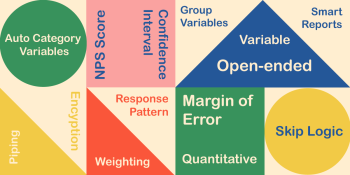Original research helps your content writing or content marketing efforts by providing value that your followers can’t get anywhere else.
Surveys are a great way to generate that content as you will develop fresh insights on topical subjects that can become newsworthy, giving you more exposure and reaching a new audience.
Once your surveys give you that data, you can “find the angle” that will hook an audience and generate interest.
Use data in a variety of content styles
- Blog posts
Demonstrate your industry knowledge to existing visitors and drive extra traffic from engines. Original research can inspire new content as well as help you strengthen existing content.
- PR articles
Depending on the topic and the results, your newly uncovered data might have the potential to make headlines – journalists are always on the lookout for their next story.
- Videos
Whether hosted on your YouTube channel or embedded on a webpage, videos capture people’s attention who might not always want to read a long article.
- Infographics
Infographics are incredibly visual and easy to share. You can include them in blogs or post to your social media.
- Training materials
If your employee survey reveals 34% respondents said they have been injured at work, this is a great stat to include in your next health and safety presentation!
TIP: You can also make white papers with your original research available for download, as a way to capture email addresses for future marketing.
Here’s how using data in your content can benefit your brand.
Brand recognition
As we know, original research can be newsworthy and topical; getting people talking and sharing your content.
Every backlink, social media share, or mention of your name in an article, will help to get your name out there.
This increased visibility and exposure will drive brand recognition, which will keep you in the minds of potential customers if they ever need your products or services.
Topical authority
If your research is picked up by news outlets, trade publications, or essay papers, you’ll build up a reputation for having a topical authority.
Being seen to have your finger on the pulse of your industry will convey you as experts and leaders in the field.
You should see the benefits across the board – from search engine visibility and website traffic to leads and sales.
Having this recognition can also result in outreach opportunities, where you may be asked to provide an expert quote or comment to a story.
Get backlinks
It’s no secret that one of the keys to a high organic Google ranking is having lots of websites link back to yours.
And one way of ensuring you get these links is to create fresh, unique content that provides value to a reader.
The more value your content offers, the more backlinks you’ll receive.
The data you get from surveys can provide insights that no-one else has uncovered yet, and is a great resource for developing fresh content.
For example, if your hospitality survey reveals that 43% of businesses are at risk of bankruptcy, you can write content around this subject that may get picked up by national newspapers or trade publications.
These links will increase the value of your website in the eyes of search engines and can lead to better visibility, more traffic, and increased sales prospects.
Outreach / Digital PR
Your data could be just what journalists are looking for. Whether it’s national news or local news, journalists are always on the hunt for new data to turn into the next hot topic.
A carefully crafted outreach email could lead to your data hitting the headlines.
You probably won’t get a backlink but you can request to be credited in the piece, which will help get your name out there.
TIP: If you’re a writer, why not craft the PR story yourself? This way you can ensure your name is featured near the start of the story – and you may even increase the likelihood of getting the piece published.
Social media
When you’re sharing research data on social media, bite-sized infographics are a great way to publish your data.
Infographics are very visual and explain data in a simple way – making it easy to read and easy to understand.
If you’re looking to present data in a way that’s easily sharable on social media, sometimes it’s best to keep it simple.
A popular way to do this is to create separate text-based infographics for each of your most topical stats.
For example: “87% of employees enjoy working from home.”
Be sure to include your brand name and logo on the infographic to ensure you receive the brand recognition whenever your content is shared.
Why data about your own content matters
As well as helping the content of your content, data can help you understand how your content is performing and what you could improve on.
Google Analytics can tell you how much traffic your content gets and how people interact with it once they click – such as how long they spend on the page and where they click next – either closing the page or clicking on an internal link.
This is important, but you need more. You need to know what people think about your content, not just what they do once they view your content.
Survey your website visitors about how they enjoy your blogs and other online content.
You can do this by emailing your database and asking for feedback – perhaps you’ll need to include a discount voucher or another incentive as a sweetner.
You can even invite people to come to your offices (post pandemic) and interact with your website in front of you – allowing you to see where they click, where their eye is drawn, and what piques their interest.



